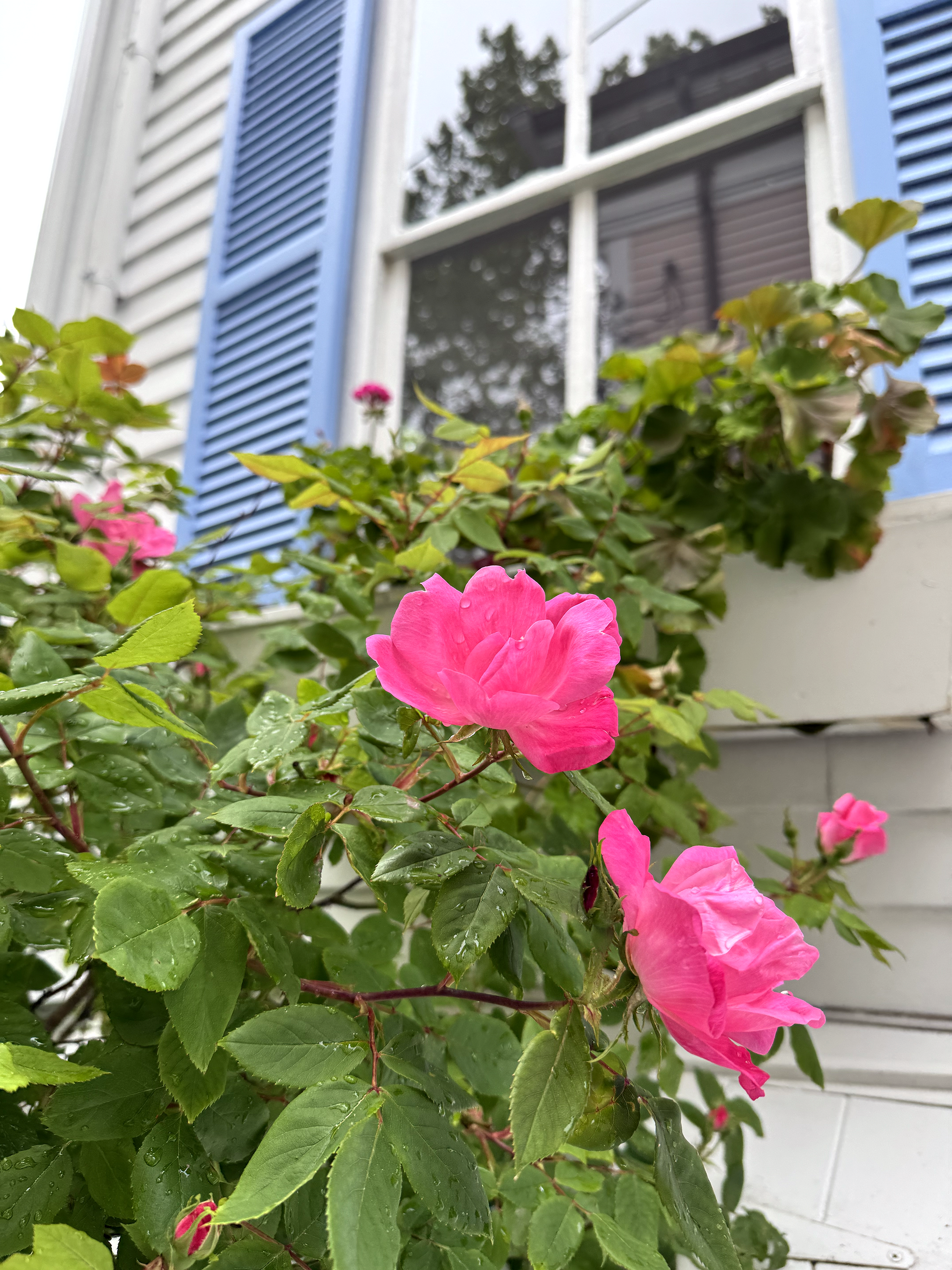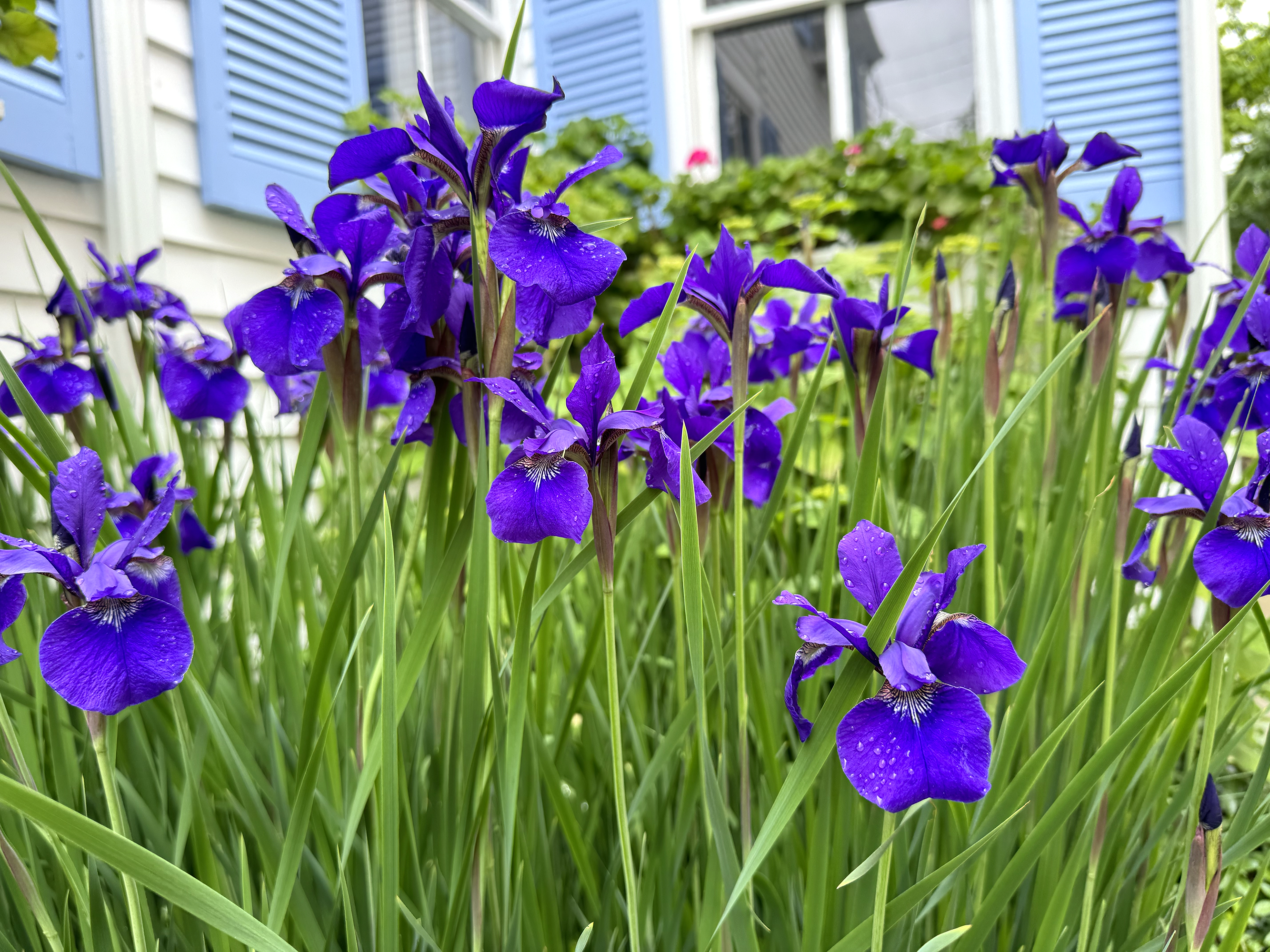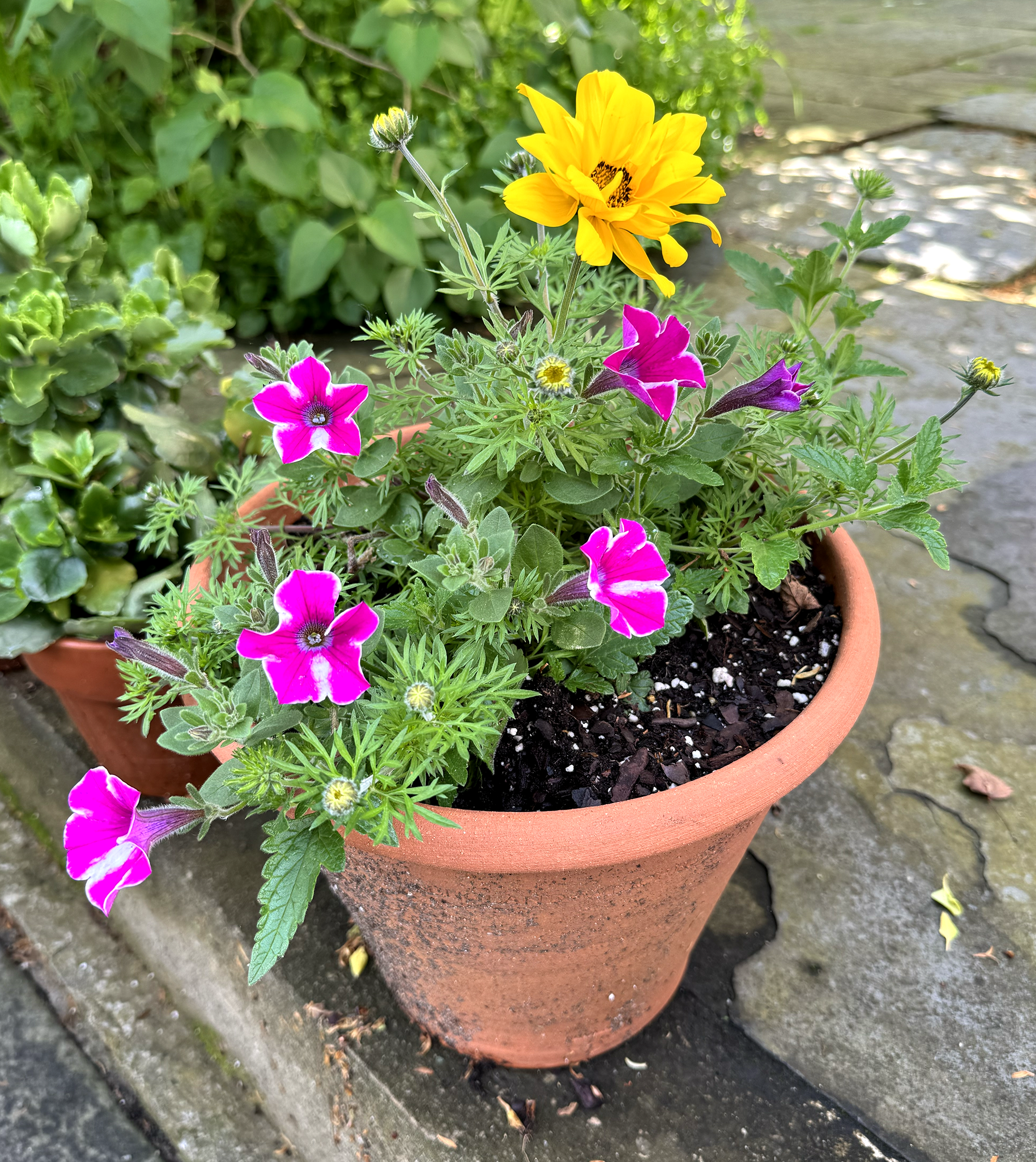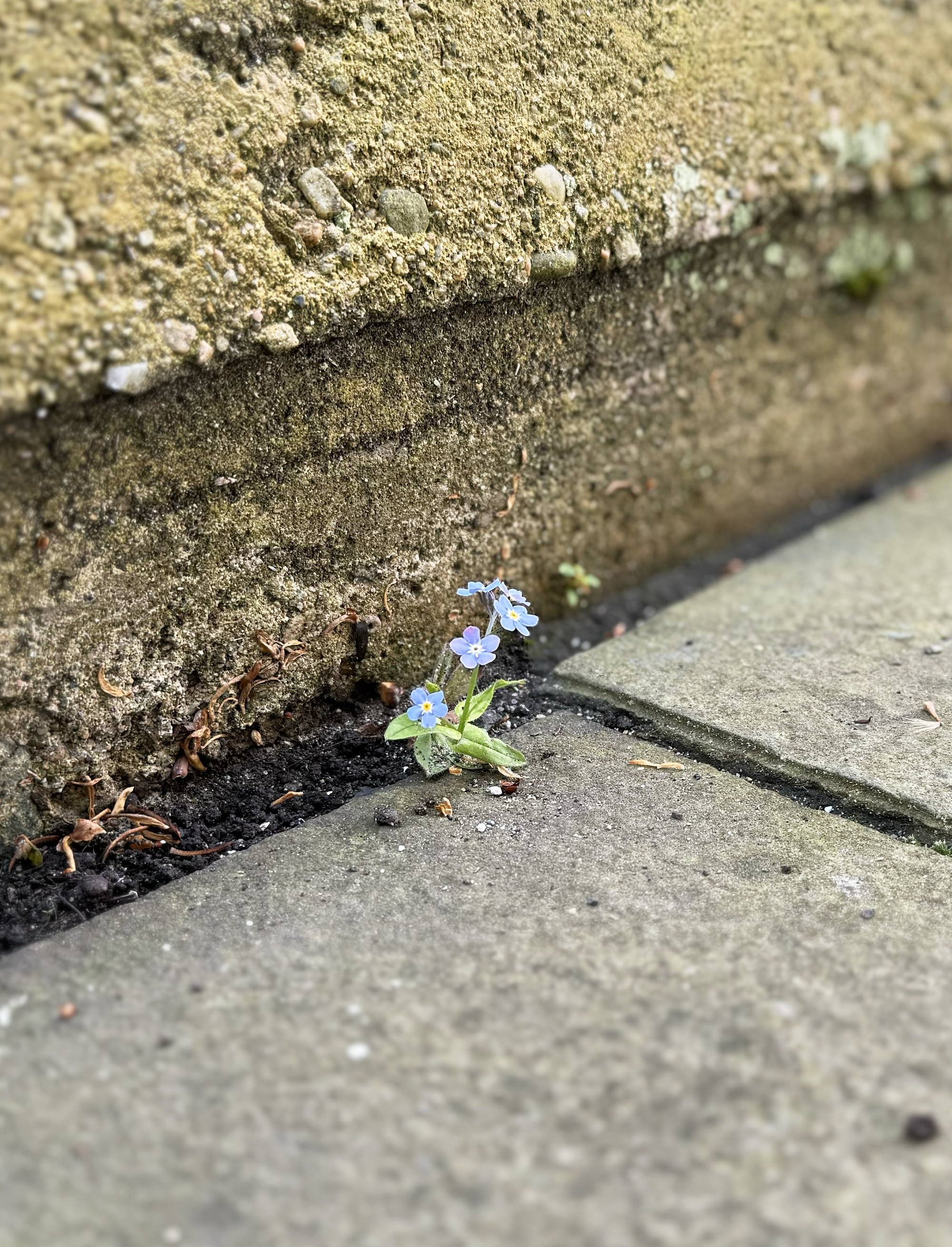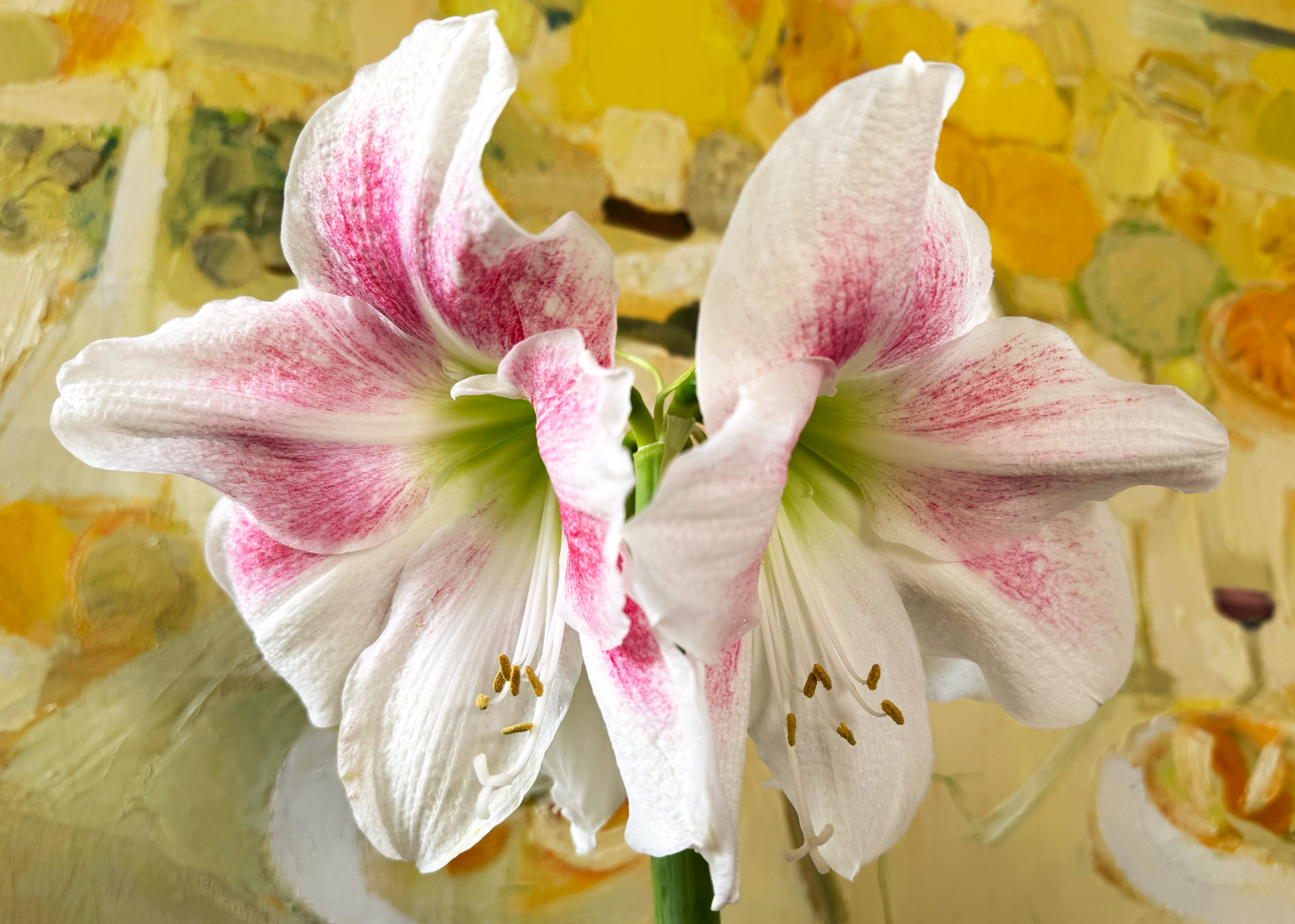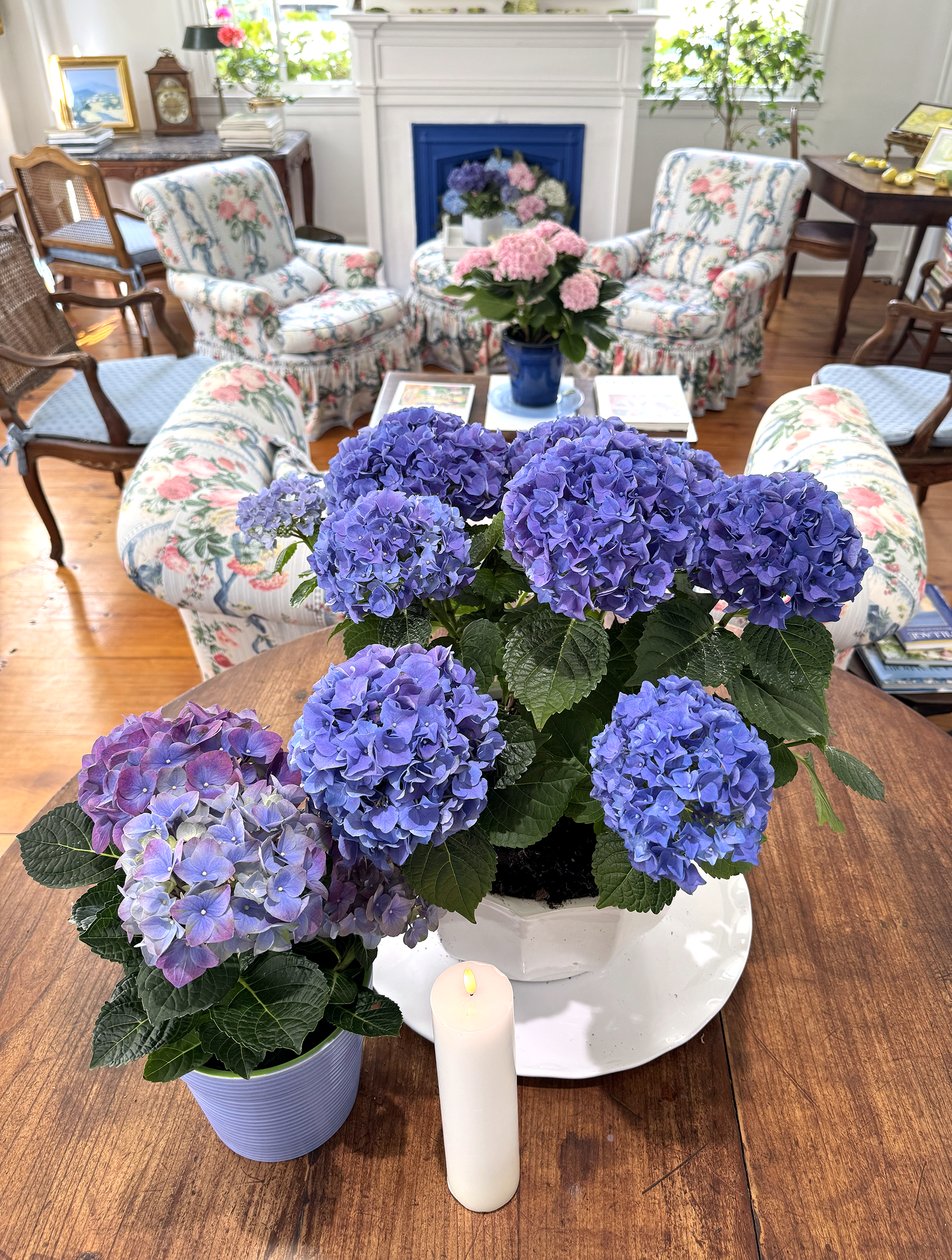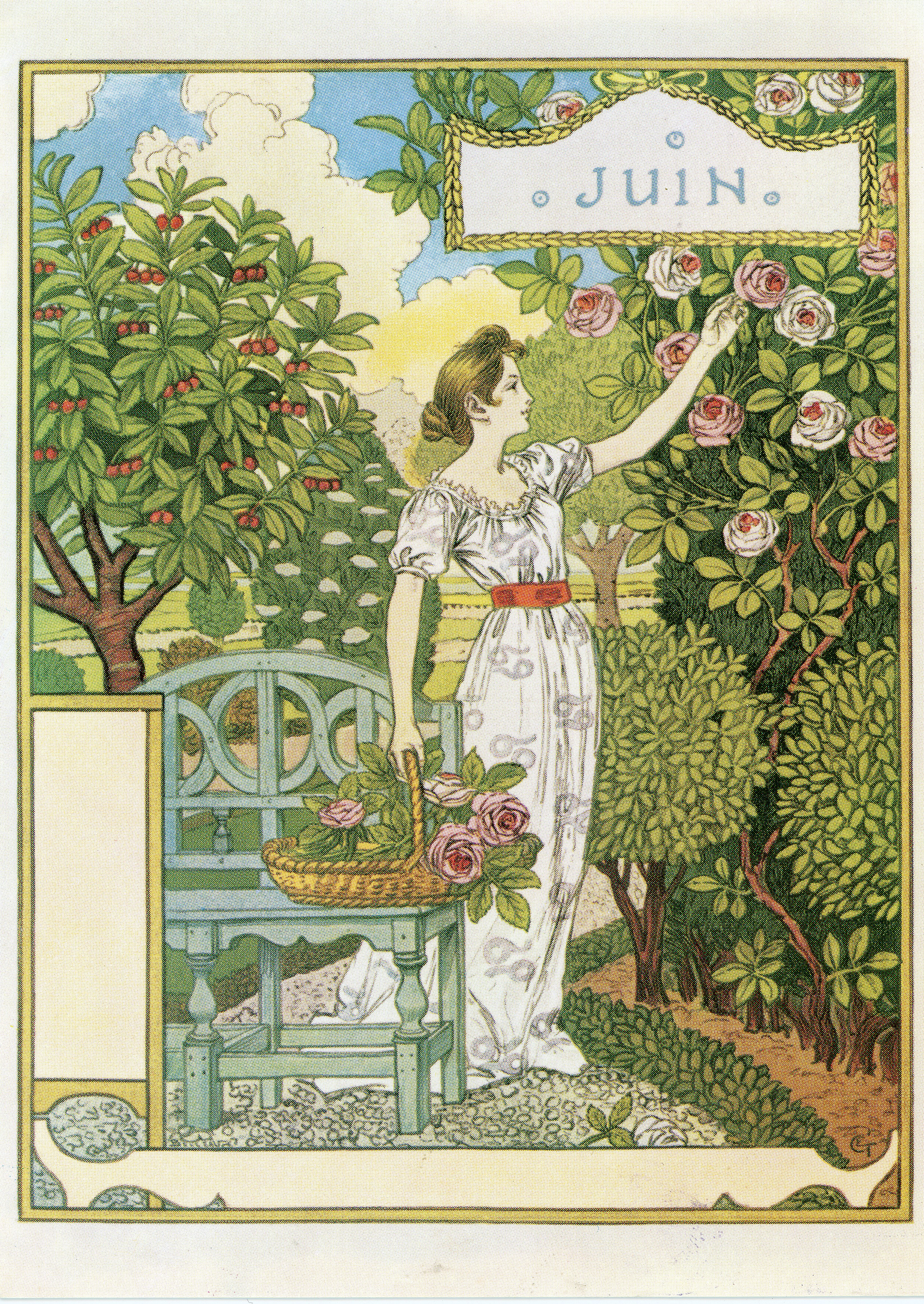AUTHOR | SPEAKER | PHILOSOPHER | DESIGNER
June 2024
“The good life is waiting for us — here and now! … At this very moment we have the necessary technique, both material and psychological, to create a full and satisfying life for everyone.” —B.F. Skinner
Dear Friends,
I love you! Happy June. The entire month of May exploded into extraordinary beauty all over the landscapes in Southeast Connecticut and our neighbor, Rhode Island. All the April showers did, indeed, bring glorious May flowers.
Last month, I showed you a photograph of the parrot tulips from Holland that my good friends Muriel and Mike gave me as a present. They had an afternoon tea party and tulip contest for good friends who had also received bulbs to plant. We were instructed to bring one stem. I was the only one who didn’t plant my bulbs myself. I asked Kevin (who helps Charlie and me with our gardens) to plunk them in randomly. Because he knows about the sun’s patterns and the neighboring trees that block optimum light, with the addition of his fairy dust, I (we) won first prize! The one blossom I brought to the contest exploded in all directions on the sunny, glorious spring afternoon our friends voted. Great fun for all tulip lovers.
On Memorial Day weekend, we saw lush green grass and tree leaves everywhere we focused our gaze. The rhododendron, azaleas, dogwood and lilacs were at their ideal splendor, dazzling our eyes with pink, purple, fuchsia and peach colors in their vivid, chromatic intensity. In Ernest Hemingway’s wonderful book A Moveable Feast, he mused, “When spring comes, even the false spring, there were no problems except where to be the happiest.”
The cottage windows were cleaned by Cesar and his team just before the “shocking pink” geraniums were returned to their rightful places in the window boxes. Whenever plants are transplanted, it takes a while for them to acclimate and settle in; because the same geraniums have graced the cottage for several years, they obviously feel comfortable and very much “at home.”
The pink peonies are showing color, and the purple irises popped into bloom. All the rosebushes are loaded with buds, and some are blossoming, revealing their various shades of pink and peach and sweetening the air with their perfume.
One rosebush is so healthy that its graceful branches were reaching toward Charlie’s house on his narrow stone walkway between our property lines. In order for him not to rip his clothes on the thorns and draw blood, we staked the protruding branches. I enjoy using the path that leads to my backyard from the street. In some terra-cotta pots on a low ledge toward my backyard, he recently planted some super fuchsia (with white) petunias with a mix of yellow and white flowers called “Rockin’ Rush.”
Charlie had planted a Japanese dogwood tree as a gift to Peter and me in 1995, when a giant oak tree in our yard that would rot our old wood houses needed to be cut down. There’s something indescribably meaningful about our joint decision to remove the rotten picket fence that separated the natural flow of beauty between our houses. It feels natural to have his purple lilac branches reaching to touch the dogwood in tenderness, creating shade for me as I sit on my garden bench. Often lost in thought as I gaze out at the harbor, inhaling the lilac-scented sea air in a light breeze, I meditate, grateful for inner peace, light breezes and my good fortune. Good neighbors don’t need fences. Sailboats catch the wind coming and going in different directions, always presenting a floating scene to observe and appreciate.
The New York Times bestselling author Mark Nepo wrote The Book of Awakening in 2000. This year, The Little Book of Awakening was published. Brooke gave it to me for “pause inspiration” before our Paris trip. One of the 52 weekly selections is his essay “Two Heart Cells Beating.” His lead quote is by Molly Vass: “If you place two living heart cells from different people in a Petri dish, they will in time find and maintain a third and common beat.” Nepo wrote about this biological fact: “There is in the very nature of life itself some essential joining force. This inborn ability to find and enliven a common beat is the miracle of love. … Being still enough, long enough, next to anything living, we find a way to sing the one voiceless song. … There exists a common beat between all hearts, just waiting to be felt.”
The Mysteries of Plant “Intelligence”
The June issue of The Atlantic magazine has a fascinating article by Zoë Schlanger in the section “Matters of Debate.” “Many scientists are awed by what we are learning about plants’ capacities,” she wrote.
How is it that plants are aware when they don’t have brains? Consciousness? Scientists now understand that some nonhuman animals clearly act intentionally. Plants are now being considered intelligent. There are botanists who don’t want to acknowledge the complexity of plants, but over time, “scientists are arguing about whether concepts like memory, consciousness, and communication can be applied beyond the animal kingdom,” Schlanger wrote.
“Trees communicate through their roots,” scientists are beginning to understand. A zoologist and chemist discovered that in a nearby forest, there had been a caterpillar invasion. “Something suddenly changed; the caterpillars began to die.” Trees that the caterpillars hadn’t yet reached “changed the composition of their leaves, turning them into weapons that would poison, and eventually kill, the caterpillar.”
This discovery taught that “trees too far apart to be connected by a root system were signaling to one another through the air.” How? Intentionally? Questions of consciousness, intelligence and communication have plant physiologists and all nature lovers in lively discussion and wonder. There are botanists and biologists who call themselves “neurobiologists.” Hmm. Neuro. All scientists seem to agree that plants (like humans) actively pursue “their own goals and, in the process, shape the very environment they find themselves rooted in,” Schlanger wrote. How can plants know what to do; how can they remember how much time there is between bee visits? Clearly, plants learn from experience. Plant lovers marvel at what they know and do. Intelligence is knowing and learning from our experiences in the outside world.
Plants don’t have a location in their structure where they store memories. They have no brain. Let their invisible knowing open us up to their wholeness and unity. Plant researcher Tilo Henning told Schlanger, “Maybe we are just not able to see these structures. Maybe they are so spread all over the body of the plant that there isn’t a single structure. Maybe that’s their trick. Maybe it’s the whole organism.”
We tell ourselves stories about ultimate mysteries that we can’t explain or fully understand. Peter’s book of wisdom, Figure It Out, is full of common sense and the good judgment of hundreds of great thinkers who have learned what is true, right and lasting. Some mysteries are stretching our imagination to wonder what if and maybe.
I’m in love with the sheer beauty, color and living art that flowers and plants provide. Going to the grocery store, flower shops, nurseries and farmer’s markets is a feast for our eyes. We’re so fortunate that we can bring the garden home to cultivate and nurture. The more I “love up” my plants and flowers, the more they respond. They become my friends and keep me company. I feel a communication, and I know they respond to the care I provide them; I don’t need scientific proof of their intelligence to know that.
"Our Town"
I was thrilled to learn that Thornton Wilder’s masterpiece play from 1938 was being performed in nearby Westerly at the Granite Theatre. Because the cast is local, it seems so appropriate to experience a beautiful play about a community, a sense of caring and how a town becomes Our Town.
Nothing could have prepared me for the brilliant ways the demand on the audience to bear witness drew us all into this community. We were invited to the wedding of Emily Webb to George Gibbs, having watched them grow up and fall in love.
The lead part is the Stage Manager, who narrates the story about the folks who live in a small town in New Hampshire. Nothing much happens, but time passes. The writing in the play is beautiful, and I was struck by so many poignant phrases.
The morning star always gets wonderful bright the minute before it has to go — doesn’t it?”
“Three years have gone by. Yes, the sun's come up over a thousand times.”
“The dead don't stay interested in us living people for very long. Gradually, gradually, they lose hold of the earth ... and the ambitions they had ... and the pleasures they had ... and the things they suffered ... and the people they loved. They get weaned away from earth — that's the way I put it — weaned away.”
“Oh earth, you’re too wonderful for anybody to realize you. … Do any human beings ever realize life while they live it — every, every minute?
"We can only be said to be alive in those moments when our hearts are conscious of our treasures.”
Peter loved Thornton Wilder’s writing and was a freshman at Yale three years after Our Town was published. Reading the play and seeing the movie can’t compare to being an active participant and seeing the beautifully crafted writing come alive. I felt I was living, breathing, crying (everyone cried; the theater gave out tissues to attendees) over the relentless, persistent theme: Wake up. This is our life. Pay attention. Now. This moment. “Look. For once in your life, look,” wrote the director of this performance of Our Town, Brad Delzer.
I asked my friend Carolyn, who went to the play with me, what she most got out of seeing the play. After a brief pause: “Life is precious.”
“Author’s Note”
The award-winning author Ann Patchett’s 2023 novel, Tom Lake, was inspired by Our Town — her “writer’s capital.” The writer Louis Auchincloss wrote a book about where authors get their ideas and inspiration. “I thank Thornton Wilder, who wrote the play that has been an enduring comfort, guide, and inspiration throughout my life,” Patchett wrote. “If this novel has a goal, it is to turn the reader back to Our Town, and to all of Wilder’s work. Therein lies the joy.”
Her novel is both moving and beautifully written. (The audio version is read by Meryl Streep.) With such vivid descriptions and details, the reader feels they can envision each scene that takes place in the spring of 2020 in Northern Michigan, where there was a theater company called Tom Lake.
A friend, also a Wilder fan, told me about Tom Lake and offered to lend it to me. Stuart told me the book is so popular that it has succeeded in exciting a renewed interest in Wilder. New York is having a revival of Our Town that opens in September. I intend to go.
Thank You for Your Gift of a Letter
Meister Eckhart, a German mystic of the 13th century, believed the two words thank you speak volumes about our deep feelings about gratitude. Thank you.
Every letter, postcard and email from you has been a true gift to me. I read each one in an elevated awareness of how meaningful it is to receive kind words of recognition. Your communications put a smile on my face and boost my energy. I am truly thankful and blessed to feel your affection and to learn more about your life. Please understand that your giving me the gift of a letter increases our sense of mutual connection and affection that we have developed over many years.
Your letters are intelligent, compassionate and deeply heartfelt; they reinforce my belief that we are bonded by a common humanity of love and goodwill. Your communications to me unite us in this powerful, personal force for good. By putting your kind, caring thoughts on paper, addressed to me, you reinforce our mutual respect, appreciation and fondness for each other. We are each lifted up to greater feelings of understanding, compassion and relatedness because of these generous connections and affection.
At this stage in my life, I’m spending peaceful, quiet time in meditation and study and less time at my writing desk. Having been blessed with longevity, I have the privilege and freedom to enjoy peaceful, pressure-free time to follow my bliss. The mythologist Joseph Campbell went away for five years to read. I’m fortunate to stay where I am and experience this spiritual joy on a daily basis.
Because I love to write, I have a fountain pen in my hand, putting thoughts to paper. Writers write. I’m not structured now because I’m free to move about in the flow of my days, balancing my energy between being and doing. Remember, “The way to do is to be.” Lao Tzu. Happiness is being; we don’t have to do anything in order to be happy.
We can take pleasure from the sparkle of sunlight on our kitchen sink as we overlook our garden. We can enjoy watching children running around on a playground. We don’t need any reason to be happy.
I’m living in the moment, taking each day as it comes. I’m embracing each new day, glad to be alive. While I don’t have nearly the same stamina I had when I started to write for publication, I find great pleasure in whatever I choose to write, mostly for my own discoveries as well as pleasure.
Free to be, I’m going to movies, plays, musicals, concerts and recitals. Each day is precious. Living well takes time. I savor my strolls in gardens, parks and water scenes. I’m doing whatever I can to stay healthy and maintain my mobility. I enjoy spending relaxed times with family and friends, blessed to be in a community of stimulating people who share their talents and skills generously. I make a point of always taking time to study and contemplate. Aristotle understood that when we are in deep thought, we are closest to the gods, and these times will be our happiest.
By taking time each day to pause and think about eternal truths, we experience a higher awareness of universal truths that teach us about our essential nature.
I’m ending this letter with great thanks to you for continuing to enrich my life in wide varieties of ways. I am always learning from you. I’m fortunate that we have become friends. You are my teachers, coaches, helpers, listeners, mentors and guides. You are my muses, companions and soulmates. All your accumulated experiences and learning are contagious. I’m a sponge absorbing all the timeless wisdom we’ve inherited as our greatest gifts.
In closing, I want to quote Epictetus, a former slave who became a Greek Stoic philosopher. I feel his message will resonate with you as we all are dealing with serious, tragic issues on the world stage:
“True instruction is this: — to learn to wish that each thing should come to pass as it does. … My pleasure lies in seeing that I myself grow better day by day.”
Enjoy all the wonder and splendor of June’s lush abundance.
Love & Live Happy,

This month, I'm letting go of a lithograph by Roger Mühl if anyone is interested in adding it to their art collection. Please contact Pauline at Artioli Findlay (pf@artiolifindlay.com) for more information.
Roger Mühl (French, 1929 - 2008)
"Provence II, Au - delà du vallon se dressait"
Limited edition French lithograph
Image and sheet size: 16 3/8 x 12 1/4 in
Executed / printed 1986
Edition # VII/XX
French landscape of umbrella trees in the foreground with valleys and mountains in the distance.


